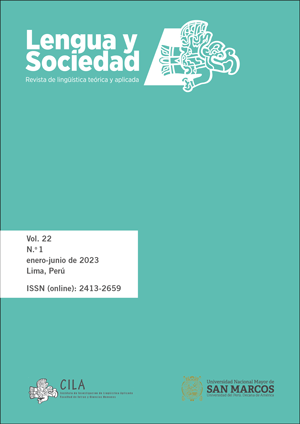Metaphors in quechua riddles or watuchis: a study from cognitive semantics
DOI:
https://doi.org/10.15381/lengsoc.v22i1.23572Keywords:
Watuchi or Quechua riddle, everyday life metaphors, metaphor classes, metaphorical expressionsAbstract
The purpose of the study is to identify, classify and expose the metaphors in Quechua riddles or watuchis, as well as the cognitive procedures for their creation. For this purpose, we will investigate the theory of metaphors proposed by Lakoff and Johnson (1980), in the book Metaphors We Live By. Methodologically, the corpus is composed of fifty riddles that were compiled and transcribed from the book Watuchikuna. This book was published in 1986 by the Centro Andino de Educación y Promoción (CADEP) "José María Arguedas" (Cusco-Peru). The results show that, in Quechua riddles, objects, fruits and animals are people; plants, animals; animals, objects; objects, living beings. Likewise, the body is a plant and the road is an object. The article concludes that most Quechua watuchis are ontological. Furthermore, in the perceptual, corporeal and cultural experience of the Quechua speaker the earth is a being that has life. Therefore, everything that exists in it has life or is personified to be expressed through the riddles.
References
Altamirano, T. (1984). Watuchicuna (adivinanzas quechuas). Anthropologica, 2(2), 387-401. https://revistas.pucp.edu.pe/index.php/anthropologica/article/view/671
Anónimo. ([1586] 2014). Arte y vocabulario en la lengua general del Perú. Edit. PUCP, Instituto Riva-Agüero.
Cáceres, G. (2006). Los Watuchi y su aplicación didáctica en un contexto de educación bilingüe intercultural. Centro Virtual Cervantes. https://cvc.cervantes.es/ensenanza/biblioteca_ele/aepe/pdf/coloquio_2006/coloquio_2006_25.pdf
Centro Andino de Educación y Promoción (CADEP) “José María Arguedas”. (1986). Watuchikuna, adivinanzas quechuas de la provincia de Anta. Edit. CADEP.
Cerrón-Palomino, R. (1987). Lingüística quechua. CERA Bartolomé de las Casas.
Cuenca, M. y Hilferty, J. (2007). Introducción a la lingüística cognitiva. Ariel.
Domingo de Santo Tomás. ([1560] 2013). Lexicón o vocabulario de la lengua general del Perú. Fondo Editorial de la USMP.
Fajardo, L. (2006). La metáfora como proceso cognitivo. Forma y Función, (19), 47-56. https://revistas.unal.edu.co/index.php/formayfuncion/article/view/18115
Gálvez, I. y Gálvez, J. (2013). Metáforas ontológicas en el quechua ayacuchano: personificación y cosificación. Letras, 84(120), 237-247. http://revista.letras.unmsm.edu.pe/index.php/le/article/view/234
González, D. ([1608] 1952). Vocabulario de la lengua general de todo el Perú llamada lengua qquichua o del inca. Instituto de Historia, Facultad de Letras de la Universidad Nacional Mayor de San Marcos
Hurtado de Mendoza, W. (2009). Metáfora y pensamiento de la cultura quechua. Edit. ANR
Lakoff, G. y Johnson, M. (1986). Metáforas de la vida cotidiana. Editorial Cátedra.
Llamas, C. (2005). Metáfora y creación léxica. Eunsa.
Lovón, M., Montenegro, M. y Chegne, A. (2021). La COVID-19 y la metáfora bélica: un análisis cognitivo en los diarios digitales y las redes sociales. Boletín de la Academia Peruana de la Lengua, 70(70), 155-196. https://doi.org/10.46744/bapl.202102.005
Mamani, A. (2018). Las metáforas de personificación en “Qalachuyma, canciones tradicionales aymaras”. Boletín de la Academia Peruana de la Lengua, 63(63), 205-220. https://doi.org/10.46744/bapl.201801.008
Manallay, P. (2022). Corporeización en la toponimia quechua. Boletín de la Academia Peruana de la Lengua, 71(71), 137-163. https://doi.org/10.46744/bapl.202201.005
Massimino, H. (2006). La metáfora vista desde la perspectiva cognitivista. www.centro-de-semiotica.com.ar/Massimino-La_metafora.htm
Raymundo, J. (2006). Las adivinanzas quechuas. Aula Intercultural. https://aulaintercultural.org/2006/05/31/las-adivinanzas-quecas/hu
Ruiz de Mendoza, J. (2009). Integración y modos de inferencia. Quaderns de Filologia. Estudis lingüístics. 14, 193-291. https://roderic.uv.es/bitstream/handle/10550/30271/193.pdf?sequence=1https://roderic.uv.es/bitstream/handle/10550/30271/193.pdf?sequence=1
Solís, N. (2021). Metáforas del caos y metonimias en los titulares de portada del tabloide Trome. Boletín de la Academia Peruana de la Lengua, 70(70), 221-247. https://doi.org/10.46744/bapl.202102.007
Soriano, C. (2012). La metáfora conceptual. En I. Ibarretxe Antuaño y J. Valenzuela (Dirs.), Lingüística cognitiva (pp. 98-121). Grupo editorial siglo XXI.
Tenorio, V. (2021). Watuchi. El enigma quechua. Editorial Altazor
Tutaya, T. (14 de octubre 2012). Watuchis (Adivinanzas). El heraldo Literario. https://heraldoliterio.blogspot.com/2012/10/watuchis-adivinanzas.html
Downloads
Published
Issue
Section
License
Copyright (c) 2023 Niel Palomino, Roxssana Arredondo

This work is licensed under a Creative Commons Attribution 4.0 International License.
AUTHORS RETAIN THEIR RIGHTS
a. Authors retain their trade mark rights and patent, and also on any process or procedure described in the article.
b. Authors can submit to the journal Lengua y Sociedad, papers disseminated as pre-print in repositories. This should be made known in the cover letter.
c. Authors retain their right to share, copy, distribute, perform and publicly communicate their article (eg, to place their article in an institutional repository or publish it in a book), with an acknowledgment of its initial publication in the journal Lengua y Sociedad.
d. Authors retain theirs right to make a subsequent publication of their work, to use the article or any part thereof (eg a compilation of his papers, lecture notes, thesis, or a book), always indicating its initial publication in the journal Lengua y Sociedad (the originator of the work, journal, volume, number and date).






